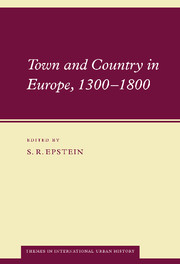Book contents
- Frontmatter
- Contents
- List of figures
- List of tables
- Notes on the contributors
- 1 Introduction. Town and country in Europe, 1300–1800
- 2 Town and country in Sweden, 1450–1650
- 3 Town and country in Holland, 1300–1550
- 4 Town and country in the Dutch Republic, 1550–1800
- 5 Town and country in England, 1300–1570
- 6 Town and country in England, 1570–1750
- 7 Town and country in the Polish Commonwealth, 1350–1650
- 8 Town and country in the Austrian and Czech lands, 1450–1800
- 9 Town and country in Germany, 1350–1600
- 10 Town and country in Switzerland, 1450–1750
- 11 Town and country in France, 1550–1750
- 12 Town and country in Castile, 1400–1650
- 13 Town and country in central and northern Italy, 1400–1800
- 14 Town and country in the kingdom of Naples, 1500–1800
- Index
13 - Town and country in central and northern Italy, 1400–1800
Published online by Cambridge University Press: 09 November 2009
- Frontmatter
- Contents
- List of figures
- List of tables
- Notes on the contributors
- 1 Introduction. Town and country in Europe, 1300–1800
- 2 Town and country in Sweden, 1450–1650
- 3 Town and country in Holland, 1300–1550
- 4 Town and country in the Dutch Republic, 1550–1800
- 5 Town and country in England, 1300–1570
- 6 Town and country in England, 1570–1750
- 7 Town and country in the Polish Commonwealth, 1350–1650
- 8 Town and country in the Austrian and Czech lands, 1450–1800
- 9 Town and country in Germany, 1350–1600
- 10 Town and country in Switzerland, 1450–1750
- 11 Town and country in France, 1550–1750
- 12 Town and country in Castile, 1400–1650
- 13 Town and country in central and northern Italy, 1400–1800
- 14 Town and country in the kingdom of Naples, 1500–1800
- Index
Summary
Introduction
The long transition in central and northern Italy from independent city-states to larger territorial states between the fourteenth and sixteenth centuries entrenched major institutional disparities in territorial organisation between regions and within the confines of the same state. A multi-faceted institutional geography was established based upon a variable combination of jurisdictional prerogatives, fiscal policies and commercial and manufacturing regulations. These configurations, whose outlines emerged for the most part during the politically and militarily fraught later middle ages, were frequently renegotiated between the sixteenth and the seventeenth centuries in response to shifts in the balance of power. Demographic change – periods of sustained population increase or, alternatively, a phase of sharp mortality crises – and economic developments – for example, manufacturing success or decline – could give rise to friction within the existing institutional set-up, or, conversely, changes in the institutional status quo could improve conditions for manufacturing activities and demographic growth. Thus, the interplay of political and economic agents and pressure groups, which jostled with each other to defend, extend or challenge the privileges and regulations inherited from the past, introduced an element of institutional dynamism. In some cases the state managed to impose a degree of centralisation and to simplify the institutional infrastructure, even at the cost of inhibiting local dynamism.
- Type
- Chapter
- Information
- Town and Country in Europe, 1300–1800 , pp. 292 - 315Publisher: Cambridge University PressPrint publication year: 2001
- 2
- Cited by



